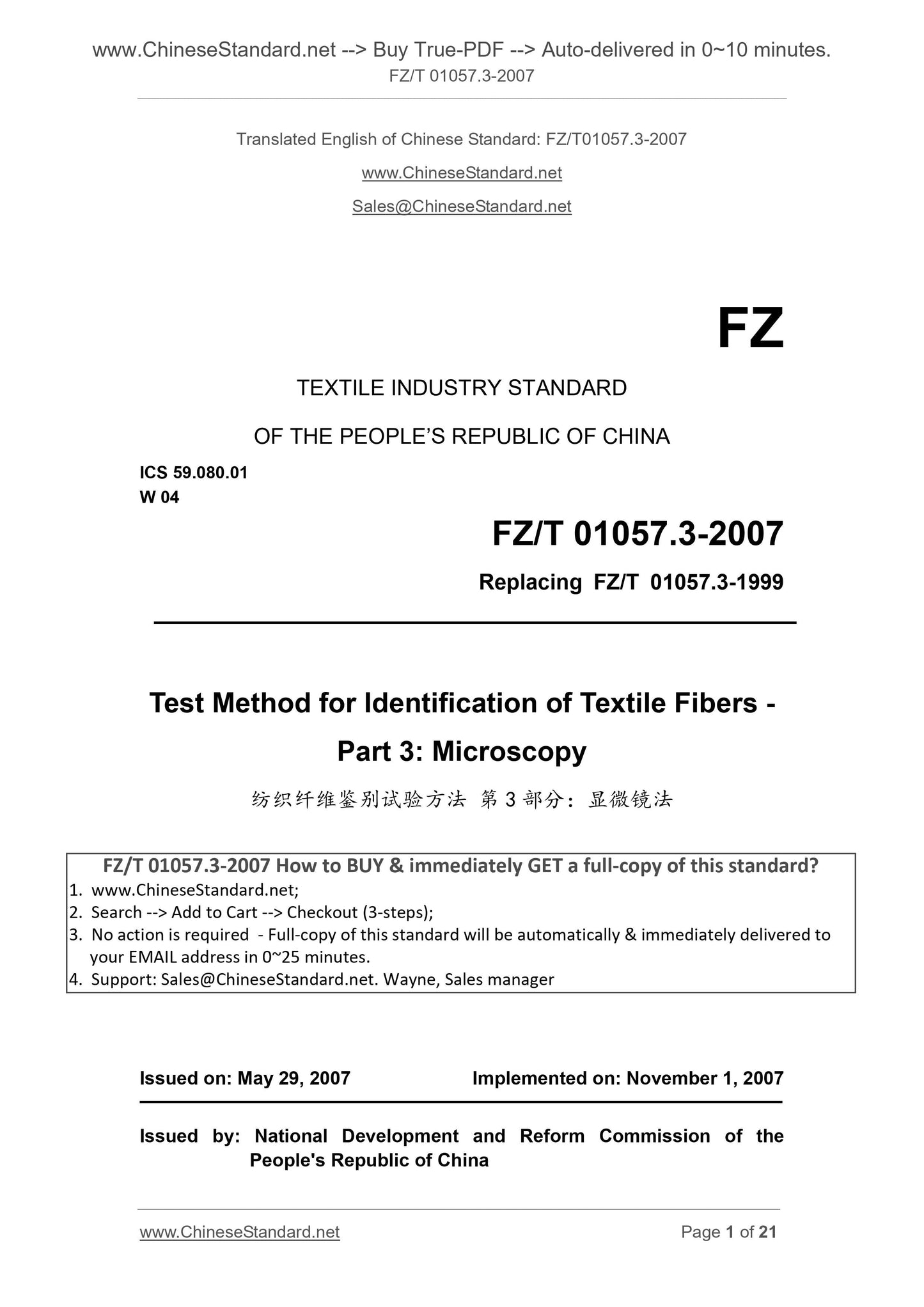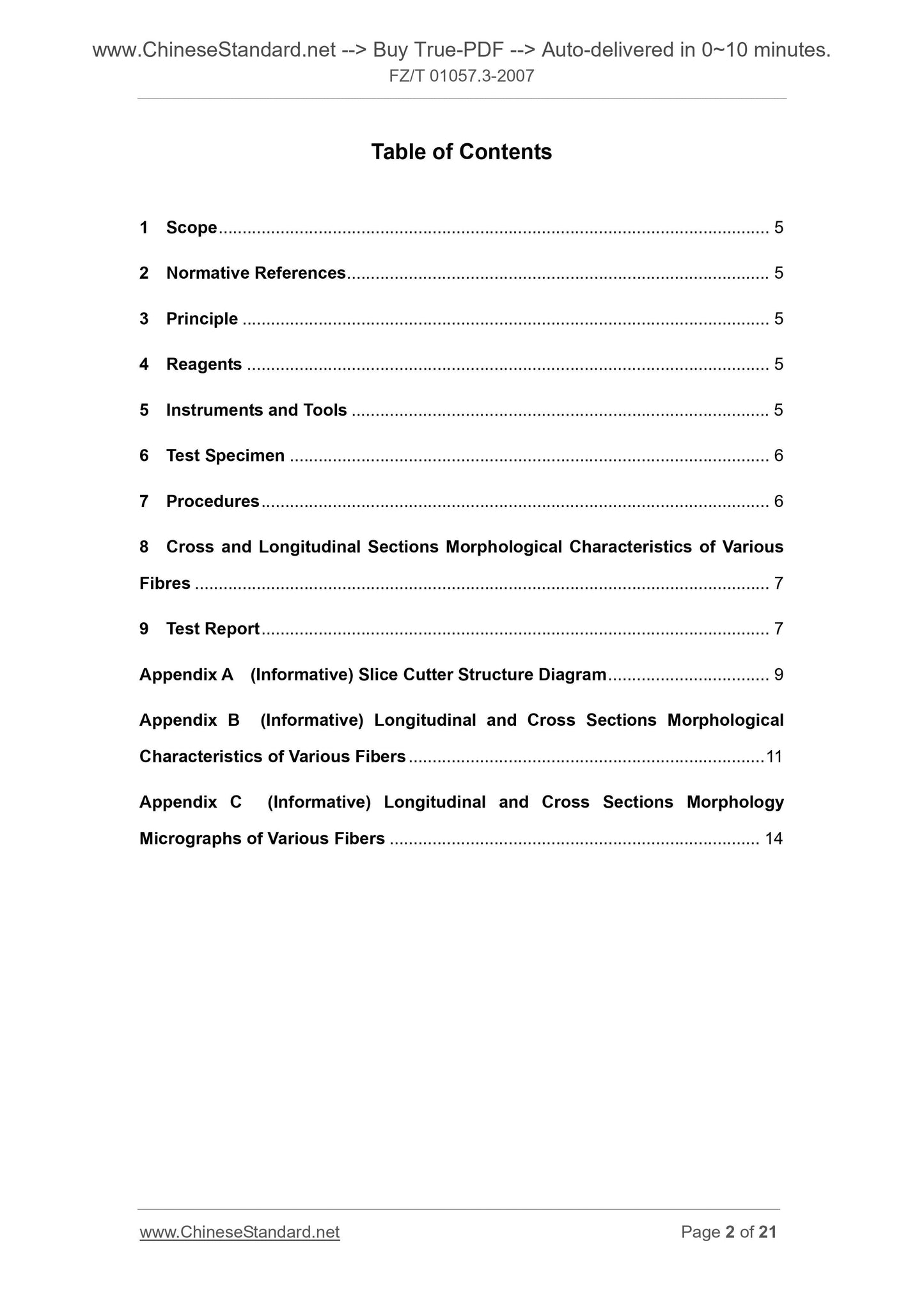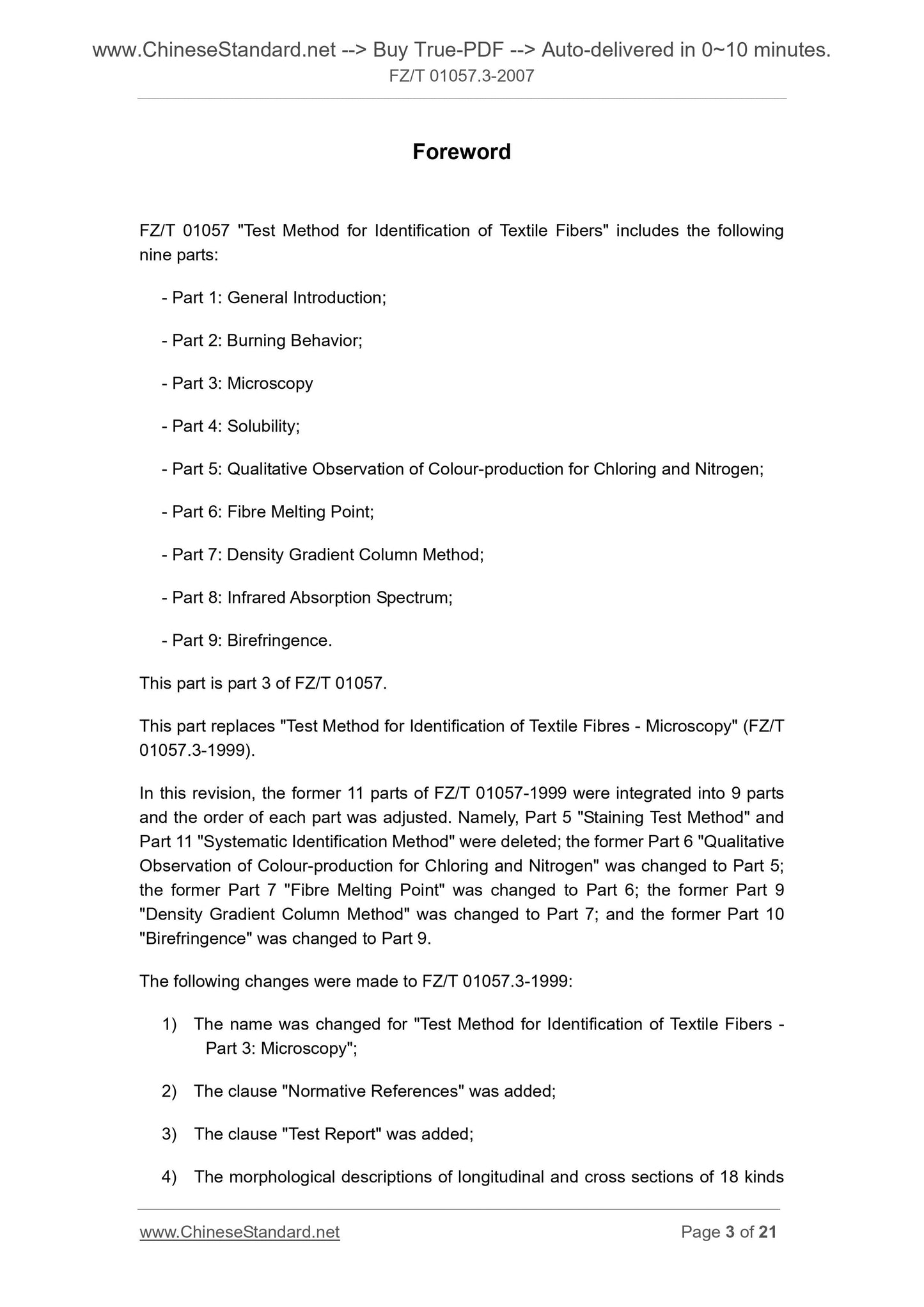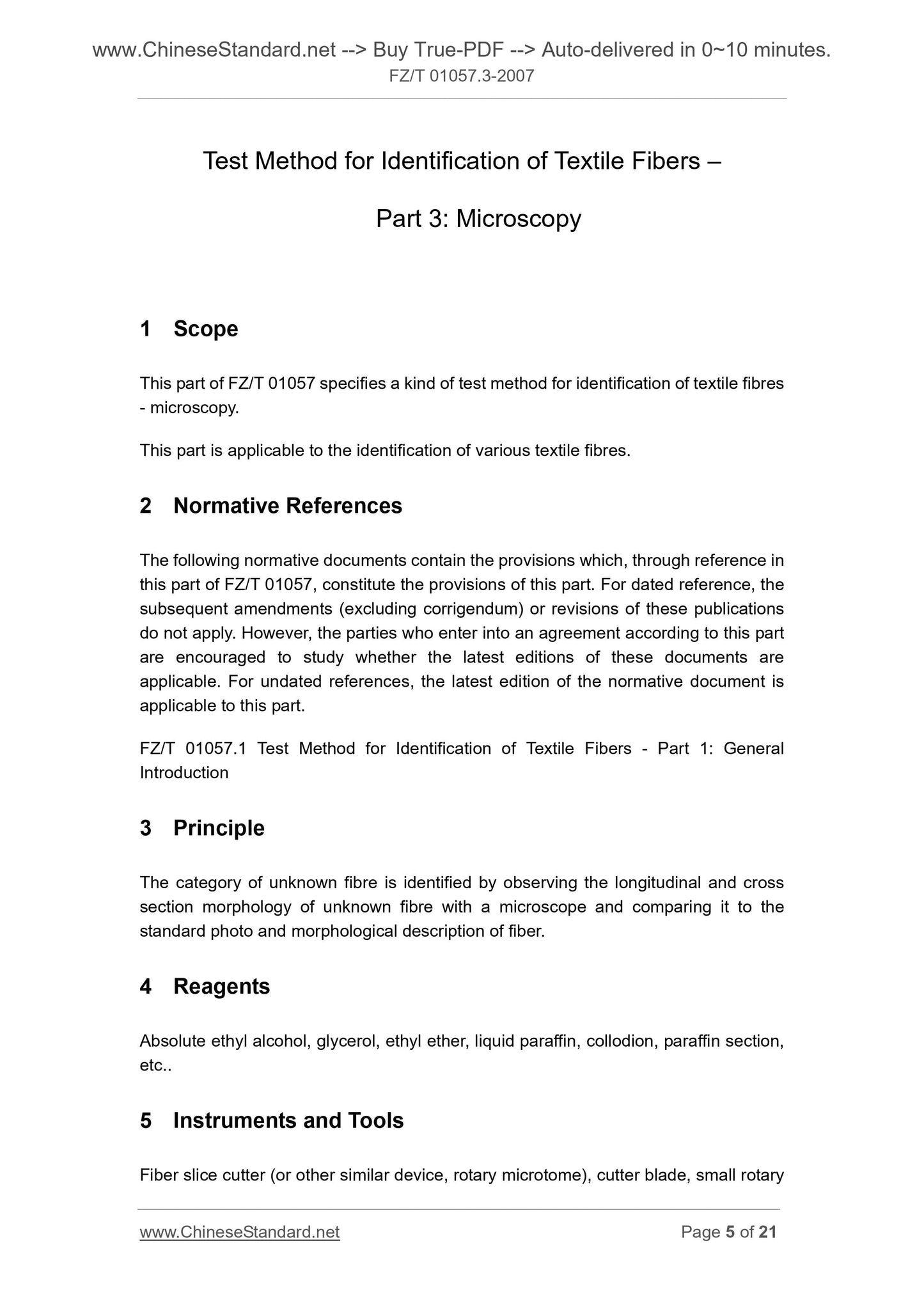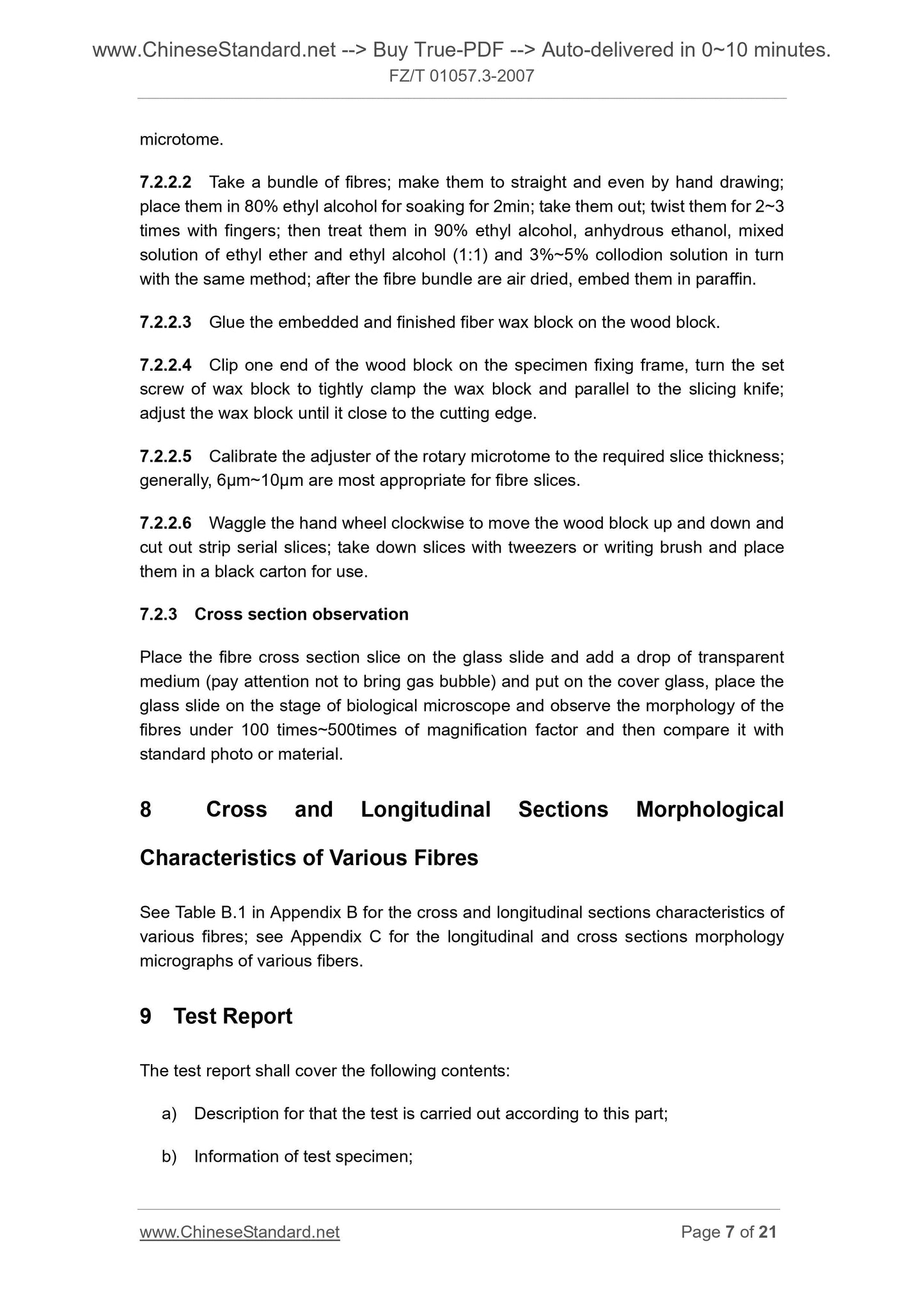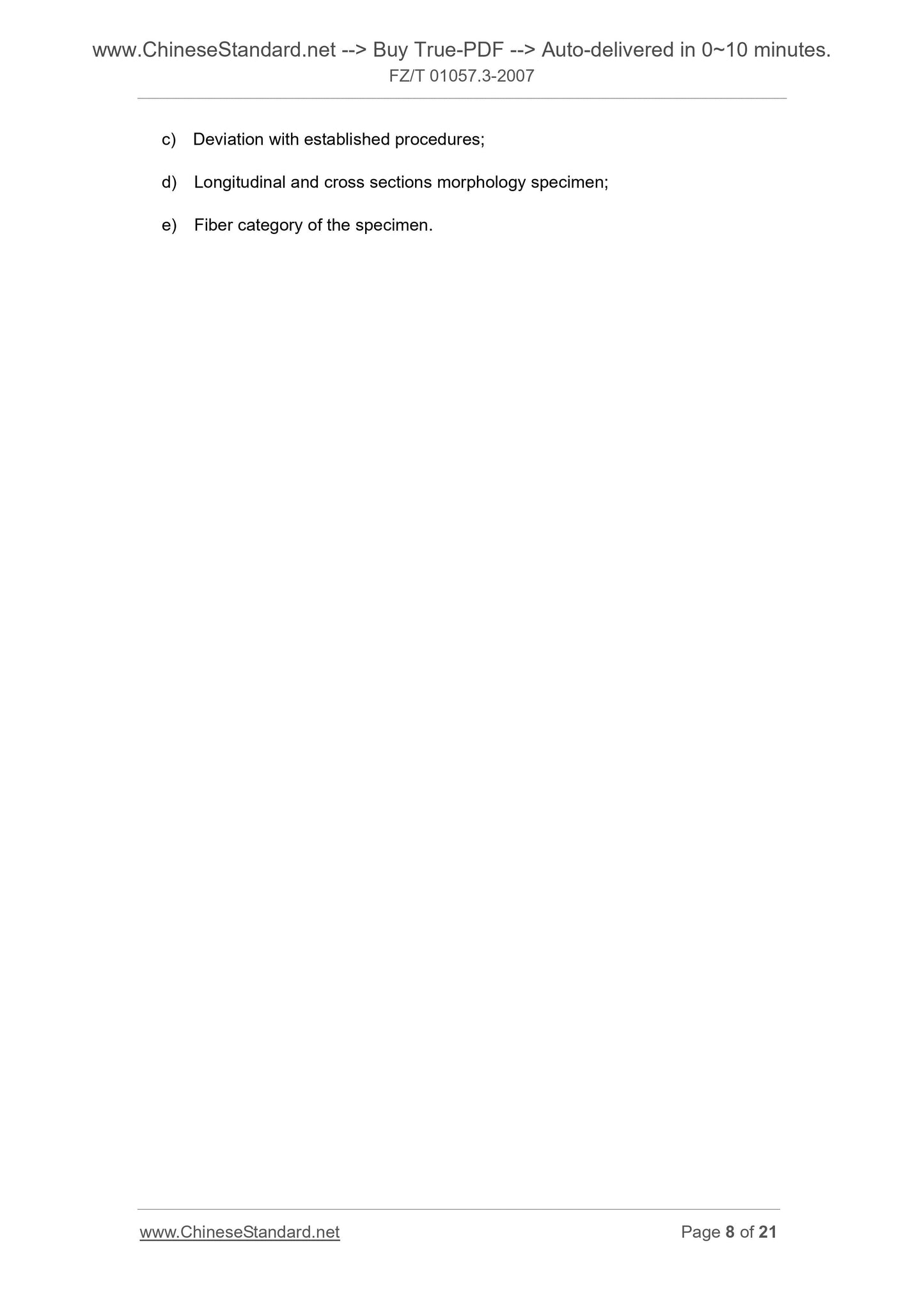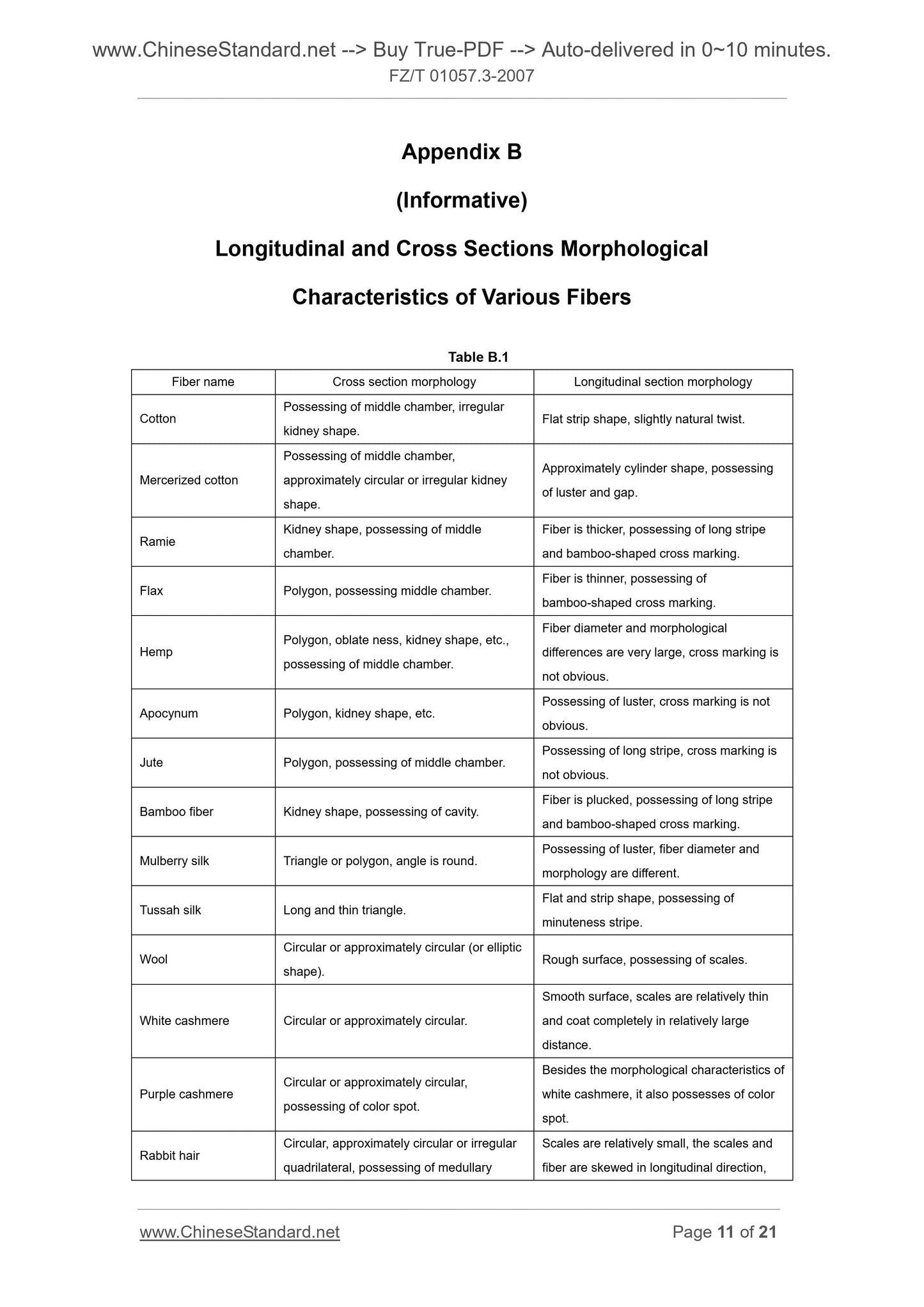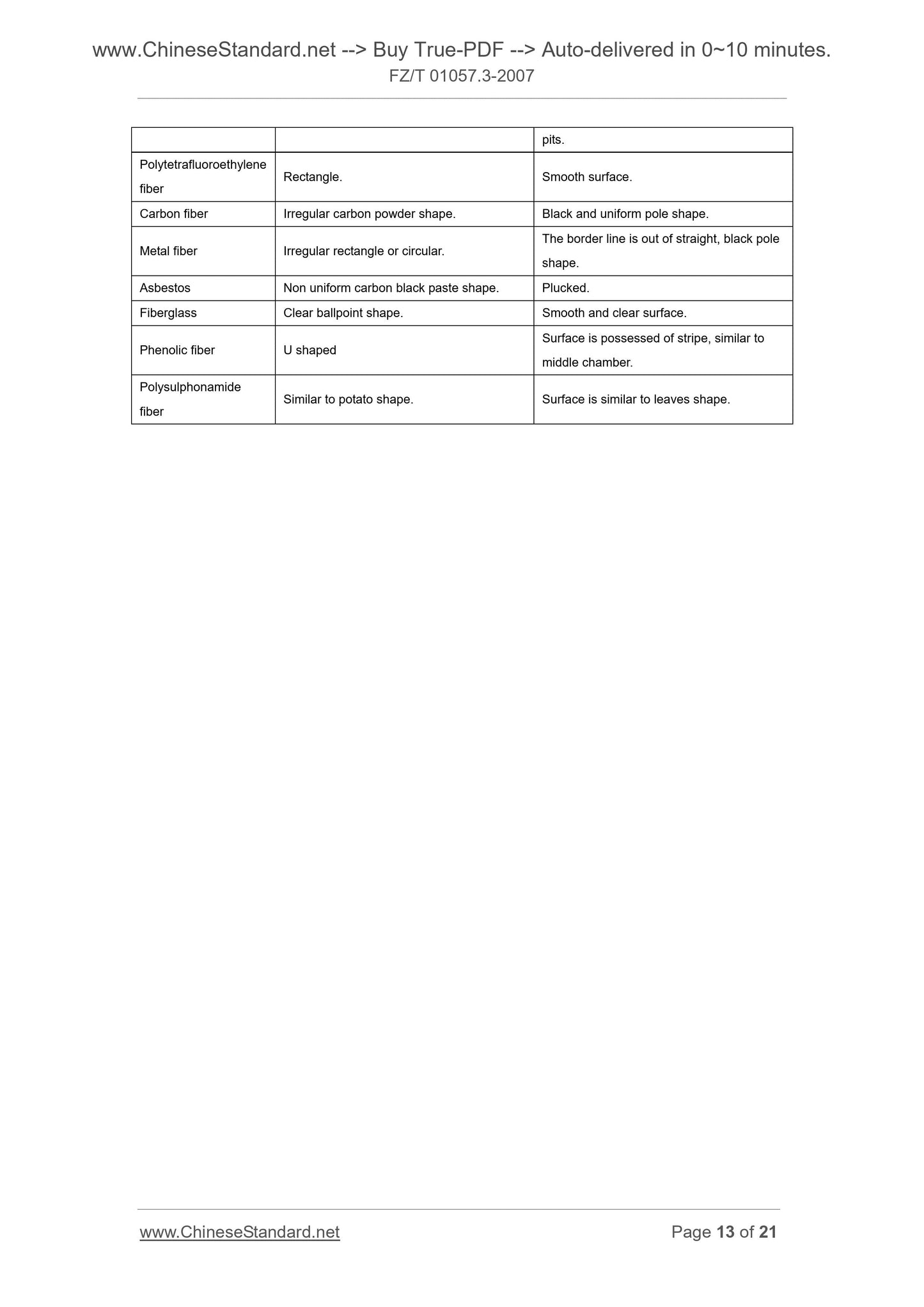PayPal, credit cards. Download editable-PDF and invoice in 1 second!
FZ/T 01057.3-2007 English PDF (FZT01057.3-2007)
FZ/T 01057.3-2007 English PDF (FZT01057.3-2007)
Precio habitual
$70.00 USD
Precio habitual
Precio de oferta
$70.00 USD
Precio unitario
/
por
Los gastos de envío se calculan en la pantalla de pago.
No se pudo cargar la disponibilidad de retiro
Delivery: 3 seconds. Download true-PDF + Invoice.
Get QUOTATION in 1-minute: Click FZ/T 01057.3-2007
Historical versions: FZ/T 01057.3-2007
Preview True-PDF (Reload/Scroll if blank)
FZ/T 01057.3-2007: Test method for identification of textile fibres - Part 3: Microscopy
FZ/T 01057.3-2007
FZ
TEXTILE INDUSTRY STANDARD
OF THE PEOPLE’S REPUBLIC OF CHINA
ICS 59.080.01
W 04
Replacing FZ/T 01057.3-1999
Test Method for Identification of Textile Fibers -
Part 3. Microscopy
ISSUED ON. MAY 29, 2007
IMPLEMENTED ON. NOVEMBER 1, 2007
Issued by. National Development and Reform Commission of the
People's Republic of China
Table of Contents
1 Scope ... 5
2 Normative References ... 5
3 Principle ... 5
4 Reagents ... 5
5 Instruments and Tools ... 5
6 Test Specimen ... 6
7 Procedures ... 6
8 Cross and Longitudinal Sections Morphological Characteristics of Various
Fibres ... 7
9 Test Report ... 7
Appendix A (Informative) Slice Cutter Structure Diagram ... 9
Appendix B (Informative) Longitudinal and Cross Sections Morphological
Characteristics of Various Fibers ... 11
Appendix C (Informative) Longitudinal and Cross Sections Morphology
Micrographs of Various Fibers ... 14
Foreword
FZ/T 01057 "Test Method for Identification of Textile Fibers" includes the following
nine parts.
- Part 1. General Introduction;
- Part 2. Burning Behavior;
- Part 3. Microscopy
- Part 4. Solubility;
- Part 5. Qualitative Observation of Colour-production for Chloring and Nitrogen;
- Part 6. Fibre Melting Point;
- Part 7. Density Gradient Column Method;
- Part 8. Infrared Absorption Spectrum;
- Part 9. Birefringence.
This part is part 3 of FZ/T 01057.
This part replaces "Test Method for Identification of Textile Fibres - Microscopy" (FZ/T
01057.3-1999).
In this revision, the former 11 parts of FZ/T 01057-1999 were integrated into 9 parts
and the order of each part was adjusted. Namely, Part 5 "Staining Test Method" and
Part 11 "Systematic Identification Method" were deleted; the former Part 6 "Qualitative
Observation of Colour-production for Chloring and Nitrogen" was changed to Part 5;
the former Part 7 "Fibre Melting Point" was changed to Part 6; the former Part 9
"Density Gradient Column Method" was changed to Part 7; and the former Part 10
"Birefringence" was changed to Part 9.
The following changes were made to FZ/T 01057.3-1999.
1) The name was changed for "Test Method for Identification of Textile Fibers -
Part 3. Microscopy";
2) The clause "Normative References" was added;
3) The clause "Test Report" was added;
4) The morphological descriptions of longitudinal and cross sections of 18 kinds
Test Method for Identification of Textile Fibers –
Part 3. Microscopy
1 Scope
This part of FZ/T 01057 specifies a kind of test method for identification of textile fibres
- microscopy.
This part is applicable to the identification of various textile fibres.
2 Normative References
The following normative documents contain the provisions which, through reference in
this part of FZ/T 01057, constitute the provisions of this part. For dated reference, the
subsequent amendments (excluding corrigendum) or revisions of these publications
do not apply. However, the parties who enter into an agreement according to this part
are encouraged to study whether the latest editions of these documents are
applicable. For undated references, the latest edition of the normative document is
applicable to this part.
FZ/T 01057.1 Test Method for Identification of Textile Fibers - Part 1. General
Introduction
3 Principle
The category of unknown fibre is identified by observing the longitudinal and cross
section morphology of unknown fibre with a microscope and comparing it to the
standard photo and morphological description of fiber.
4 Reagents
Absolute ethyl alcohol, glycerol, ethyl ether, liquid paraffin, collodion, paraffin section,
etc..
5 Instruments and Tools
Fiber slice cutter (or other similar device, rotary microtome), cutter blade, small rotary
microtome.
7.2.2.2 Take a bundle of fibres; make them to straight and even by hand drawing;
place them in 80% ethyl alcohol for soaking for 2min; take them out; twist them for 2~3
times with fingers; then treat them in 90% ethyl alcohol, anhydrous ethanol, mixed
solution of ethyl ether and ethyl alcohol (1.1) and 3%~5% collodion solution in turn
with the same method; after the fibre bundle are air dried, embed them in paraffin.
7.2.2.3 Glue the embedded and finished fiber wax block on the wood block.
7.2.2.4 Clip one end of the wood block on the specimen fixing frame, turn the set
screw of wax block to tightly clamp the wax block and parallel to the slicing knife;
adjust the wax block until it close to the cutting edge.
7.2.2.5 Calibrate the adjuster of the rotary microtome to the required slice thickness;
generally, 6μm~10μm are most appropriate for fibre slices.
7.2.2.6 Waggle the hand wheel clockwise to move the wood block up and down and
cut out strip serial slices; take down slices with tweezers or writing brush and place
them in a black carton for use.
7.2.3 Cross section observation
Place the fibre cross section slice on the glass slide and add a drop of transparent
medium (pay attention not to bring gas bubble) and put on the cover glass, place the
glass slide on the stage of biological microscope and observe the morphology of the
fibres under 100 times~500times of magnification factor and then compare it with
standard photo or material.
8 Cross and Longitudinal Sections Morphological
Characteristics of Various Fibres
See Table B.1 in Appendix B for the cross and longitudinal sections characteristics of
various fibres; see Appendix C for the longitudinal and cross sections morphology
micrographs of various fibers.
9 Test Report
The test report shall cover the following contents.
a) Description for that the test is carried out according to this part;
b) Information of test specimen;
c) Deviation with established procedures;
d) Longitudinal and cross sections morphology specimen;
e) Fiber category of the specimen.
Appendix B
(Informative)
Longitudinal and Cross Sections Morphological
Characteristics of Various Fibers
Table B.1
Fiber name Cross section morphology Longitudinal section morphology
Cotton Possessing of middle chamber, irregular kidney shape. Flat strip shape, slightly natural twist.
Mercerized cotton
Possessing of middle chamber,
approximately circular or irregular kidney
shape.
Approximately cylinder shape, possessing
of luster and gap.
Ramie Kidney shape, possessing of middle chamber.
Fiber is thicker, possessing of long stripe
and bamboo-shaped cross marking.
Flax Polygon, possessing middle chamber. Fiber is thinner, possessing of bamboo-shaped cross marking.
Hemp Polygon, oblate ness, kidney shape, etc., possessing of middle chamber.
Fiber diameter and morphological
differences are very large, cross marking is
not obvious.
Apocynum Polygon, kidney shape, etc. Possessing of luster, cross marking is not obvious.
Jute Polygon, possessing of middle chamber. Possessing of long stripe, cross marking is not obvious.
Bamboo fiber Kidney shape, possessing of cavity. Fiber is plucked, possessing of long stripe and bamboo-shaped cross marking.
Mulberry silk Triangle or polygon, angle is round. Possessing of luster, fiber diameter and morphology are different.
Tussah silk Long and thin triangle. Flat and strip shape, possessing of minuteness stripe.
Wool Circular or approximately circular (or elliptic shape). Rough surface, possessing of scales.
White cashmere Circular or approximately circular.
Smooth surface, scale...
Get QUOTATION in 1-minute: Click FZ/T 01057.3-2007
Historical versions: FZ/T 01057.3-2007
Preview True-PDF (Reload/Scroll if blank)
FZ/T 01057.3-2007: Test method for identification of textile fibres - Part 3: Microscopy
FZ/T 01057.3-2007
FZ
TEXTILE INDUSTRY STANDARD
OF THE PEOPLE’S REPUBLIC OF CHINA
ICS 59.080.01
W 04
Replacing FZ/T 01057.3-1999
Test Method for Identification of Textile Fibers -
Part 3. Microscopy
ISSUED ON. MAY 29, 2007
IMPLEMENTED ON. NOVEMBER 1, 2007
Issued by. National Development and Reform Commission of the
People's Republic of China
Table of Contents
1 Scope ... 5
2 Normative References ... 5
3 Principle ... 5
4 Reagents ... 5
5 Instruments and Tools ... 5
6 Test Specimen ... 6
7 Procedures ... 6
8 Cross and Longitudinal Sections Morphological Characteristics of Various
Fibres ... 7
9 Test Report ... 7
Appendix A (Informative) Slice Cutter Structure Diagram ... 9
Appendix B (Informative) Longitudinal and Cross Sections Morphological
Characteristics of Various Fibers ... 11
Appendix C (Informative) Longitudinal and Cross Sections Morphology
Micrographs of Various Fibers ... 14
Foreword
FZ/T 01057 "Test Method for Identification of Textile Fibers" includes the following
nine parts.
- Part 1. General Introduction;
- Part 2. Burning Behavior;
- Part 3. Microscopy
- Part 4. Solubility;
- Part 5. Qualitative Observation of Colour-production for Chloring and Nitrogen;
- Part 6. Fibre Melting Point;
- Part 7. Density Gradient Column Method;
- Part 8. Infrared Absorption Spectrum;
- Part 9. Birefringence.
This part is part 3 of FZ/T 01057.
This part replaces "Test Method for Identification of Textile Fibres - Microscopy" (FZ/T
01057.3-1999).
In this revision, the former 11 parts of FZ/T 01057-1999 were integrated into 9 parts
and the order of each part was adjusted. Namely, Part 5 "Staining Test Method" and
Part 11 "Systematic Identification Method" were deleted; the former Part 6 "Qualitative
Observation of Colour-production for Chloring and Nitrogen" was changed to Part 5;
the former Part 7 "Fibre Melting Point" was changed to Part 6; the former Part 9
"Density Gradient Column Method" was changed to Part 7; and the former Part 10
"Birefringence" was changed to Part 9.
The following changes were made to FZ/T 01057.3-1999.
1) The name was changed for "Test Method for Identification of Textile Fibers -
Part 3. Microscopy";
2) The clause "Normative References" was added;
3) The clause "Test Report" was added;
4) The morphological descriptions of longitudinal and cross sections of 18 kinds
Test Method for Identification of Textile Fibers –
Part 3. Microscopy
1 Scope
This part of FZ/T 01057 specifies a kind of test method for identification of textile fibres
- microscopy.
This part is applicable to the identification of various textile fibres.
2 Normative References
The following normative documents contain the provisions which, through reference in
this part of FZ/T 01057, constitute the provisions of this part. For dated reference, the
subsequent amendments (excluding corrigendum) or revisions of these publications
do not apply. However, the parties who enter into an agreement according to this part
are encouraged to study whether the latest editions of these documents are
applicable. For undated references, the latest edition of the normative document is
applicable to this part.
FZ/T 01057.1 Test Method for Identification of Textile Fibers - Part 1. General
Introduction
3 Principle
The category of unknown fibre is identified by observing the longitudinal and cross
section morphology of unknown fibre with a microscope and comparing it to the
standard photo and morphological description of fiber.
4 Reagents
Absolute ethyl alcohol, glycerol, ethyl ether, liquid paraffin, collodion, paraffin section,
etc..
5 Instruments and Tools
Fiber slice cutter (or other similar device, rotary microtome), cutter blade, small rotary
microtome.
7.2.2.2 Take a bundle of fibres; make them to straight and even by hand drawing;
place them in 80% ethyl alcohol for soaking for 2min; take them out; twist them for 2~3
times with fingers; then treat them in 90% ethyl alcohol, anhydrous ethanol, mixed
solution of ethyl ether and ethyl alcohol (1.1) and 3%~5% collodion solution in turn
with the same method; after the fibre bundle are air dried, embed them in paraffin.
7.2.2.3 Glue the embedded and finished fiber wax block on the wood block.
7.2.2.4 Clip one end of the wood block on the specimen fixing frame, turn the set
screw of wax block to tightly clamp the wax block and parallel to the slicing knife;
adjust the wax block until it close to the cutting edge.
7.2.2.5 Calibrate the adjuster of the rotary microtome to the required slice thickness;
generally, 6μm~10μm are most appropriate for fibre slices.
7.2.2.6 Waggle the hand wheel clockwise to move the wood block up and down and
cut out strip serial slices; take down slices with tweezers or writing brush and place
them in a black carton for use.
7.2.3 Cross section observation
Place the fibre cross section slice on the glass slide and add a drop of transparent
medium (pay attention not to bring gas bubble) and put on the cover glass, place the
glass slide on the stage of biological microscope and observe the morphology of the
fibres under 100 times~500times of magnification factor and then compare it with
standard photo or material.
8 Cross and Longitudinal Sections Morphological
Characteristics of Various Fibres
See Table B.1 in Appendix B for the cross and longitudinal sections characteristics of
various fibres; see Appendix C for the longitudinal and cross sections morphology
micrographs of various fibers.
9 Test Report
The test report shall cover the following contents.
a) Description for that the test is carried out according to this part;
b) Information of test specimen;
c) Deviation with established procedures;
d) Longitudinal and cross sections morphology specimen;
e) Fiber category of the specimen.
Appendix B
(Informative)
Longitudinal and Cross Sections Morphological
Characteristics of Various Fibers
Table B.1
Fiber name Cross section morphology Longitudinal section morphology
Cotton Possessing of middle chamber, irregular kidney shape. Flat strip shape, slightly natural twist.
Mercerized cotton
Possessing of middle chamber,
approximately circular or irregular kidney
shape.
Approximately cylinder shape, possessing
of luster and gap.
Ramie Kidney shape, possessing of middle chamber.
Fiber is thicker, possessing of long stripe
and bamboo-shaped cross marking.
Flax Polygon, possessing middle chamber. Fiber is thinner, possessing of bamboo-shaped cross marking.
Hemp Polygon, oblate ness, kidney shape, etc., possessing of middle chamber.
Fiber diameter and morphological
differences are very large, cross marking is
not obvious.
Apocynum Polygon, kidney shape, etc. Possessing of luster, cross marking is not obvious.
Jute Polygon, possessing of middle chamber. Possessing of long stripe, cross marking is not obvious.
Bamboo fiber Kidney shape, possessing of cavity. Fiber is plucked, possessing of long stripe and bamboo-shaped cross marking.
Mulberry silk Triangle or polygon, angle is round. Possessing of luster, fiber diameter and morphology are different.
Tussah silk Long and thin triangle. Flat and strip shape, possessing of minuteness stripe.
Wool Circular or approximately circular (or elliptic shape). Rough surface, possessing of scales.
White cashmere Circular or approximately circular.
Smooth surface, scale...
Share
